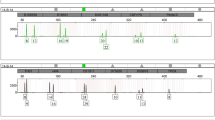Abstract
Formalin fixation is commonly used to preserve tissue sections for pathological testing and embalming cadavers for medical dissection or burial. DNA extracted from formalin-fixed tissues may also provide an alternative source of genetic material for medical diagnosis and forensic casework, such as identifying unknown embalmed human remains. Formaldehyde causes DNA damage, chemical modifications, and degradation, thereby reducing the quantity and quality of DNA available for downstream genetic analyses. By comparing the DNA yield, level of DNA degradation, and short tandem repeat (STR) success of various tissue types, this study is the first of its kind to provide some guidance on which samples from embalmed bodies are likely to generate more complete STR profiles. Tissue samples were dissected from three male embalmed cadavers and included bone, cartilage, hair, muscle, internal organs, skin, teeth, and nail clippings. DNA was purified from all samples using the QIAamp® FFPE Tissue Kit (Qiagen), quantified using the QuantiFiler® Trio DNA Quantification kit (Life Technologies), and genotyped using the GlobalFiler® PCR Amplification Kit (Life Technologies). Results of this study showed variation in DNA quantity and STR success between different types of tissues and some variation between cadavers. Overall, bone marrow samples resulted in the highest DNA yields, the least DNA degradation, and greatest STR success. However, several muscle, hair, and nail samples generated higher STR success rates than traditionally harvested bone and tooth samples. A key advantage to preferentially using these tissue samples over bone (and marrow) and teeth is their comparative ease and speed of collection from the cadaver and processing during DNA extraction. Results also indicate that soft tissues affected by lividity (blood pooling) may experience greater exposure to formalin, resulting in more DNA damage and reduced downstream STR success than tissues under compression. Overall, we recommend harvesting from selected muscles (gastrocnemius, rectus femoris, flexor digitorum brevis, masseter, brachioradialis) or fingernails for human identification purposes.



Similar content being viewed by others
References
Farrugia A, Keyser C, Ludes B (2010) Efficiency evaluation of a DNA extraction and purification protocol on archival formalin-fixed and paraffin-embedded tissue. Forensic Sci Int 194:25–28
Funabashi K et al. (2012) DNA extraction and molecular analysis of non-tumoral liver, spleen, and brain from autopsy samples: the effect of formalin fixation and paraffin embedding. Pathol Res Pract:584–591
Baden M (2005) Exhumation. In: Spitze W, Spitz D (eds) Medicolegal investigation of death: guidelines for the application of pathology to crime investigation, 4th edn. Springfield, Illinois, pp. 174–183
Foer F (1998) Exhumation. Slate. http://www.slate.com/articles/news_and_politics/the_gist/1998/05/exhumation.html. Accessed 29 April 2015
Okello J. B, et al (2010) Comparison of methods in the recovery of nucleic acids from archival formalin-fixed paraffin-embedded autopsy tissues. Anal Biochem 1:110–117.
Bedino J (2003) Embalming chemistry: glutaraldehyde versus formaldehyde. The Champion Company. http://champion-newera.com/CHAMP.PDFS/encyclo649.pdf. Accessed 23 June 2015
Hansen J et al. (2014) DNA and RNA analysis of blood and muscle from bodies with variable postmortem intervals. Forensic Sci Med Pathol 3:322–328
Taguchi M et al. (2012) DNA identification of formalin-fixed organs is affected by fixation time and type of fixatives: using the AmpF l STR(R) Identifiler(R) PCR Amplification Kit. Med Sci Law 1:12–16
Lin J et al. (2009) High-quality genomic DNA extraction from formalin-fixed and paraffin-embedded samples deparaffinized using mineral oil. Anal Biochem 2:265–267
Ludyga N (2012) Nucleic acids from long-term preserved FFPE tissues are suitable for downstream analyses. Virchows Arch 2:131–140
Zagga A et al. (2013) PCR inhibitory effects of aldehyde fixing agents on DNA extracted from embalmed human skeletal fragments and teeth specimens. Nurs Health Sci 1:33–37
Korthuis R (2011) Skeletal muscle circulation. Colloquium series on integrated systems physiology. Morgan & Claypool Life Sciences, San Rafael
Rizk S (2010) Anatomy & Physiology. Augusta Tech University. http://www.augustatech.edu/anatomy/links_ap2.htm. Accessed on 25 June 2015
Saladin K. (2011) Support and movement. In: Anatomy & Physiology, 6th edn. New York City, New York, pp 180–309
Goff L (2009) Early post-mortem changes and stages of decomposition in exposed cadavers. Exp Appl Acarol 1:21–36
Mathur A (2011) An overview of methods used for estimation of time since death. Aust J Forensic Sci 4:275–285
Mundorff A, Davoren J (2014) Examination of DNA yield rates for different skeletal elements at increasing post mortem intervals. Forensic Sci Int Genet 8:55–63
Pooniya S et al. (2014) Quality and quantity of extracted deoxyribonucleic acid (DNA) from preserved soft tissues of putrefied unidentifiable human corpse. J Lab Phys 6:31–35
Topp T et al. (2012) Embalmed and fresh frozen human bones in orthopedic cadaveric studies: which bone is authentic and feasible? Acta Orthop 83:543–547
QIAGEN (2012) QIAamp DNA FFPE Tissue Handbook. Qiagen https://www.qiagen.com/gb/resources/download.aspx?id=63a84dc7-d904-418e-b71a-1521cf318e82&lang=en. Accessed on 27 April 2015
Life Technologies (2014) Quantifiler HP and Trio quantification kits user guide. Thermo fisher scientific brand. https://tools.thermofisher.com/content/sfs/manuals/4485354.pdf. Accessed on 27 April 2015
LifeTechnologies (2014) GlobalFiler PCR Amplification Kit. Thermo Fisher Scientific Brand. Accessed on 27 April 2015
Westen A, Gerretsen R, Maat G (2008) Femur, rib, and tooth sample collection for DNA analysis in disaster victim identification (DVI): a method to minimize contamination risk. Forensic Sci Med Pathol 4:15–21
von Wurmb-Schwark N et al. (2008) The impact of DNA contamination of bone samples in forensic case analysis and anthropological research. Legal Med 10:125–130
Ossowski A et al. (2013) Example of human individual identification from World War II gravesite. Forensic Sci Int 233:179–192
Vernarecci S et al. (2015) Quantifiler Trio Kit and forensic samples management: a matter of degradation. Forensic Sci Int Genet 16:77–85
Acknowledgments
We would like to thank Samantha Tippen for collecting a subset of the cadaveric tissue samples. We would also like to acknowledge Sheri Olsen at Life Technologies for kindly providing the QuantiFiler® Trio DNA Quantification kit used in this study. The authors would also like to thank the staff at STAFS for their assistance, and the individuals and families of those who donated their bodies to STAFS for scientific research.
Author information
Authors and Affiliations
Corresponding author
Ethics declarations
Conflict of interest
The authors declare that they have no conflict of interest.
Ethical standards
All experiments performed in this research were conducted within the current laws of the USA. Code 45 Code of Federal Regulations part 46102(f) exempts the requirement for Institutional review board (IRB) regarding the use of cadaveric samples.
Electronic supplementary material
Online Resource 1
(DOC 109 kb)
Online Resource 2
(DOC 335 kb)
Online Resource 3
(DOC 594 kb)
Online Resource 4
(DOC 296 kb)
Online Resource 5
(DOC 52 kb)
Online Resource 6
(DOC 79 kb)
Online Resource 7
(DOC 55 kb)
Online Resource 8
(DOC 54 kb)
Online Resource 9
(DOC 90 kb)
Online Resource 10
(DOC 58 kb)
Rights and permissions
About this article
Cite this article
Wheeler, A., Czado, N., Gangitano, D. et al. Comparison of DNA yield and STR success rates from different tissues in embalmed bodies. Int J Legal Med 131, 61–66 (2017). https://doi.org/10.1007/s00414-016-1405-5
Received:
Accepted:
Published:
Issue Date:
DOI: https://doi.org/10.1007/s00414-016-1405-5




